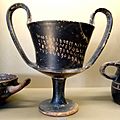Kylix facts for kids
A kylix was a special kind of cup used for drinking wine in ancient Greece. It was the most common type of wine cup. Imagine a wide, shallow bowl on a short stand, with two handles sticking out from the sides. This shape was very popular! Another type of wine cup was the kantharos, which was taller and had handles that went straight up.
The flat inside bottom of the cup was called the tondo. This was often the main spot for amazing paintings. These paintings were done in styles like black-figure or red-figure pottery during the 500s and 400s BC. The outside of the cup was often painted too. When you poured wine into the cup, the pictures would be hidden. As you drank, the scenes would slowly appear! Artists often planned their designs so that the pictures would surprise or entertain the drinker as they were revealed.
The word "kylix" comes from the Greek word kylix, meaning "cup." This word is related to the Latin word calix, which is where our English word "chalice" comes from. In ancient Greece, the term "kylix" was used quite broadly. Many different kinds of kylixes were simply called "cups." Like all other types of Greek pottery, they are also generally called "vases."
Contents
Famous Ancient Greek Cups
Many kylixes are famous for their beautiful artwork or interesting stories. Here are a few examples:
Arkesilas Cup
The Arkesilas Cup is very special because it shows a real person from history. It features Arkesilaos II, who was a king of Kyrene. He died in 550 BC. This cup was made around 565 or 560 BC and is now in Paris, France.
Dionysus Cup
The Dionysus Cup is well-known for its incredible painting. It was created between 540 and 530 BC. This cup is considered a masterpiece by the Attic Black-figure potter named Exekias. It is one of the most important artworks in the Staatliche Antikensammlungen museum in Munich, Germany.
Berlin Foundry Cup
The Berlin Foundry Cup is a red-figure kylix from the early 400s BC. It gets its name from the artist who painted it, known as the Foundry Painter. The most amazing part of this cup is the detailed picture on the outside. It shows people working in an Athenian bronze workshop or foundry. This cup gives us important clues about how ancient Greeks used metal-working technology.
Brygos Cup of Würzburg
The Brygos Cup of Würzburg is an Attic red-figure kylix made around 480 BC. It was created by a potter named Brygos and painted by the artist known as the Brygos Painter. The scenes on this cup show ancient Greek parties called symposiums. These images are some of the most famous examples of Greek pottery art.
Images for kids
-
Kylix by Euergides (circa 500 BC) in the British Museum
-
Eye-cup, painted with eyes
-
Merrythought cup, with distinctive "wishbone" handles
-
For comparison, a black-glaze kantharos with Boeotian inscription (Thespiae, 450–425 BC)
See also
 In Spanish: Cílica para niños
In Spanish: Cílica para niños













